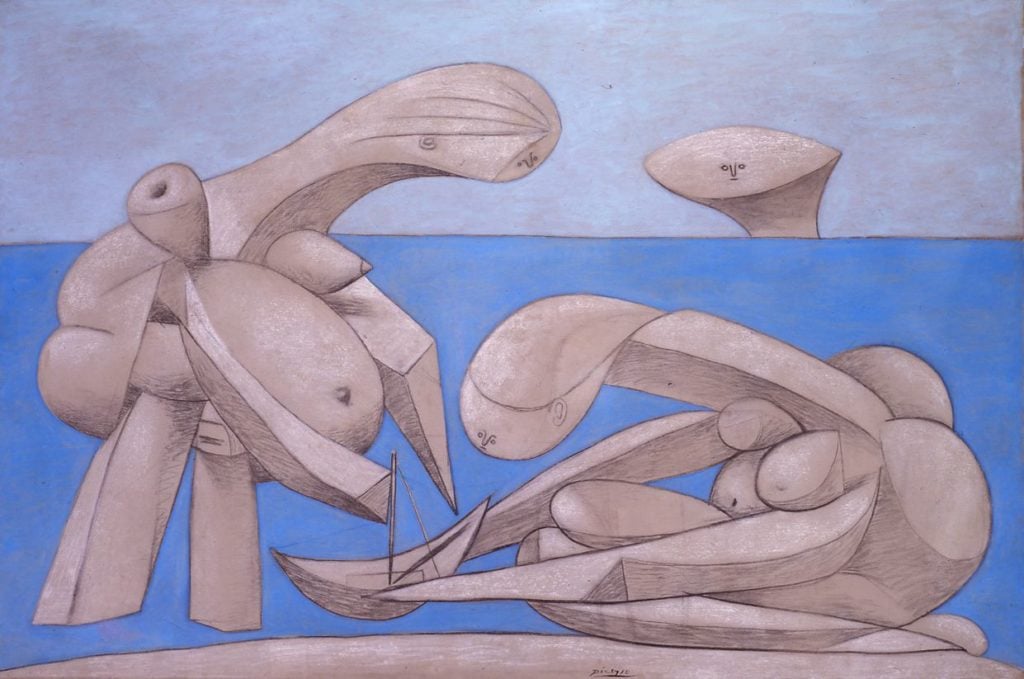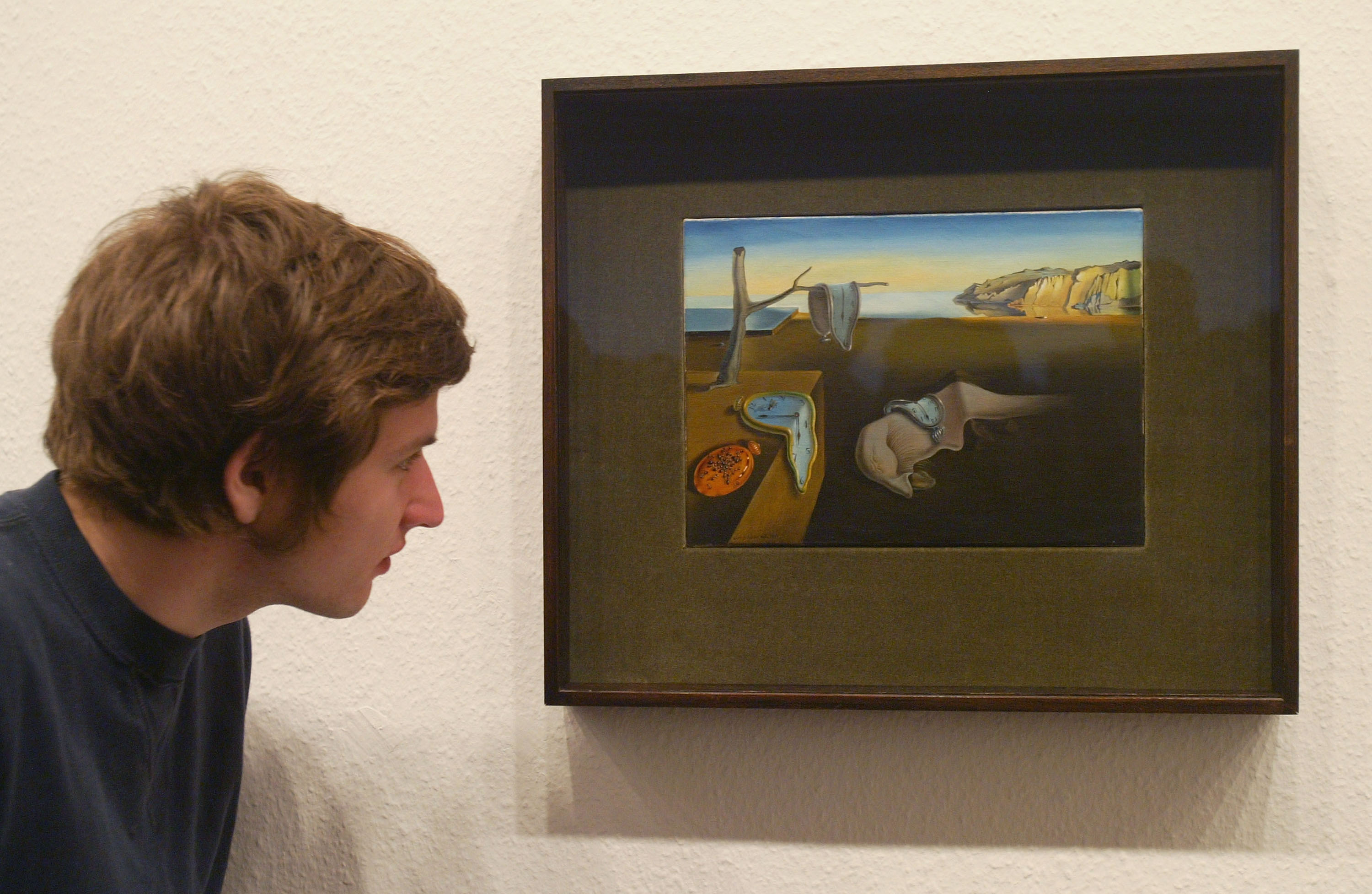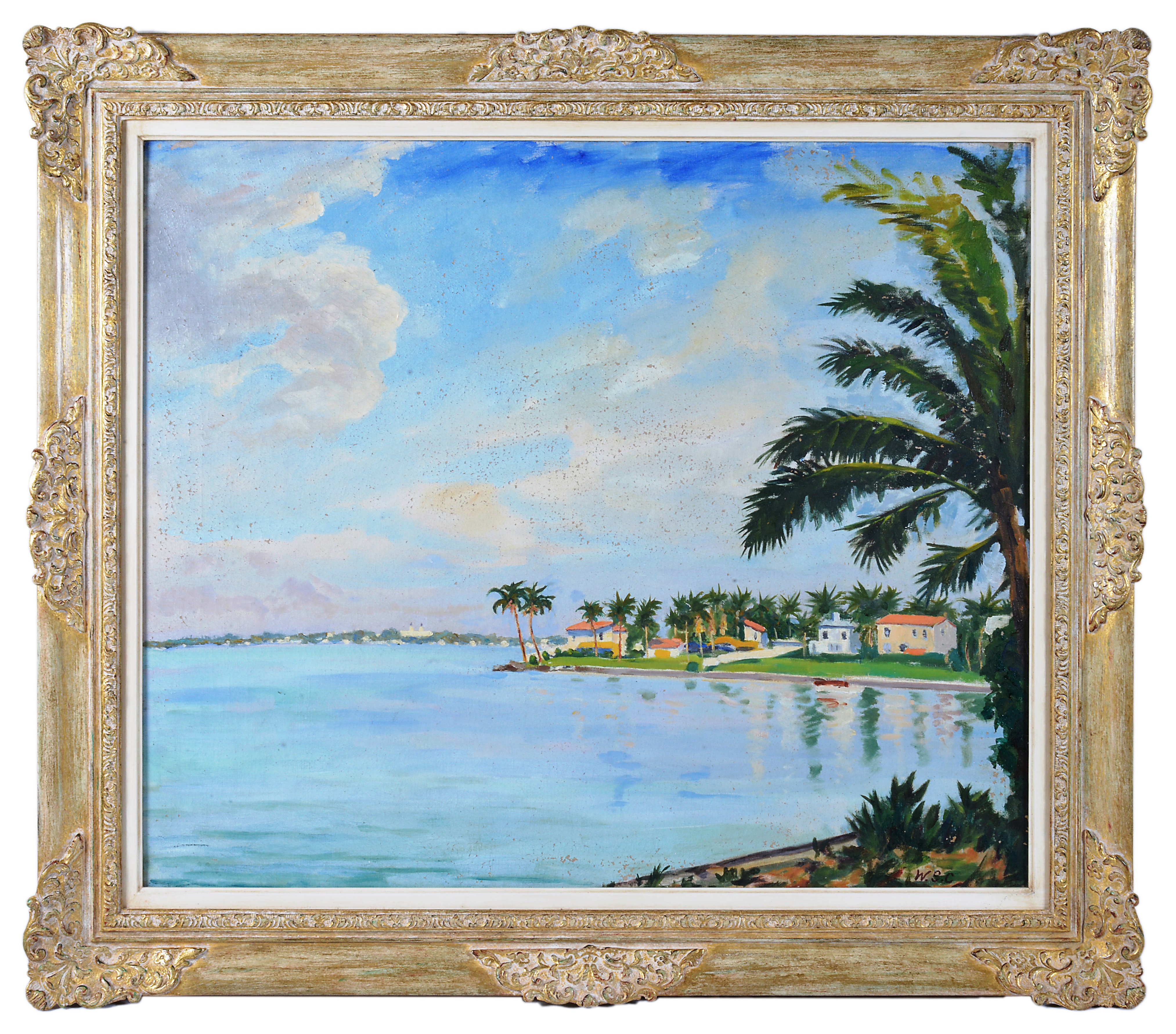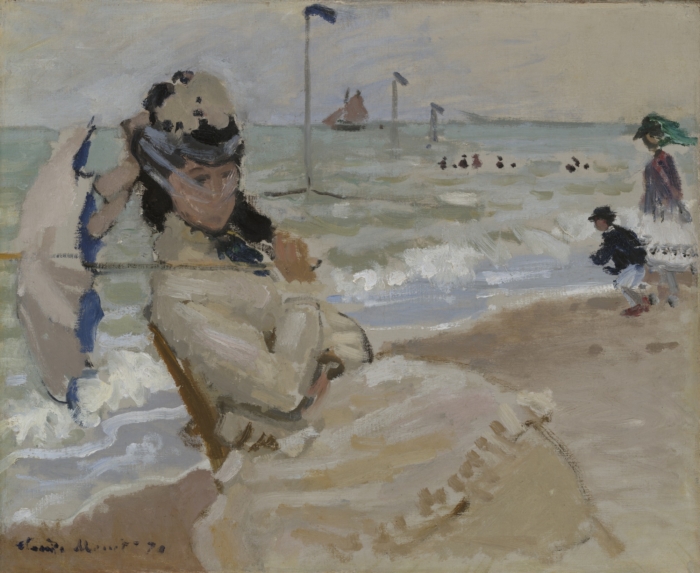
Summer is a time to explore galleries and museums both at home and abroad as well as the best season to hit the beach. So, if you can, why not do both at the same time? We’ve rounded up 10 of the best beaches in art, some of which you can actually visit, others which must be journeyed to via the mind’s eye.
1. Pablo Picasso, On the Beach (1937)
In contrast with Picasso’s earlier, more hedonistic beach scenes of say Two Women Running on the Beach (1922), this later work by the Cubist painter adopts a more melancholy tone. In it, two female figures are depicted fiddling with what appears to be a small toy boat as an unidentified party looks on from afar. Some interpret the head looming on the horizon as a potential reference to the grim backdrop painted by the looming spectre of the Spanish Civil War.
In contrast with Picasso’s earlier, more hedonistic beach scenes of say Two Women Running on the Beach (1922), this later work by the Cubist painter adopts a more melancholy tone. In it, two female figures are depicted fiddling with what appears to be a small toy boat as an unidentified party looks on from afar. Some interpret the head looming on the horizon as a potential reference to the grim backdrop painted by the looming spectre of the Spanish Civil War.
On the Beach can be viewed in the Peggy Guggenheim Collection in Venice.

A visitor takes a look at Salvador Dali’s The Persistence of Memory at the MoMA exhibit, on March 24, 2004 in Berlin, Germany. Photo Sean Gallup/Getty Images.
2. Salvador Dalí, The Persistence of Memory (1931)
The iconic melting clocks painting is probably one of Dalí’s best known works, but a lesser known fact about it is that the depicted dreamscape is actually furnished with reality: the seaside location of the painting is loosely based on Cadaqués beach in Catalonia, where the surrealist painter visited during his childhood.
The iconic melting clocks painting is probably one of Dalí’s best known works, but a lesser known fact about it is that the depicted dreamscape is actually furnished with reality: the seaside location of the painting is loosely based on Cadaqués beach in Catalonia, where the surrealist painter visited during his childhood.
The Persistence of Memory is on view at MoMA.

Winston Churchill, Untitled (1946). Photo courtesy of Boningtons.
3. Winston Churchill, Untitled (1946)
First and foremost a politician, Winston Churchill was also a painter, thought to have completed over 500 oil paintings in his lifetime. We may know his famous “We shall fight on the beaches” speech but did you know he also painted on them? This oil painting by the former prime minister of a Miami beach in Florida recently sold for £192,000 ($254,000) at a Boningtonsauction.
First and foremost a politician, Winston Churchill was also a painter, thought to have completed over 500 oil paintings in his lifetime. We may know his famous “We shall fight on the beaches” speech but did you know he also painted on them? This oil painting by the former prime minister of a Miami beach in Florida recently sold for £192,000 ($254,000) at a Boningtonsauction.

Antony Gormley, Another Place (1997). Photo Wikimedia Commons.
4. Antony Gormley, Another Place (1997)
If you’re not travelling this summer, here’s one you can visit on a staycation. Originally exhibited on the beach of Cuxhaven in Germany, the 100 cast iron sculptures that make up Antony Gormley’s installation Another Place are now settled permanently at Crosby Beach in Liverpool. The modern sculptures, facing out to sea, are casts of Gormley’s own body rather than depictions of valiant heroes from history or mythic scenes. The iron men appear deep in thought, perhaps stirred by the sublime body of water to contemplate their own position in time and space.
If you’re not travelling this summer, here’s one you can visit on a staycation. Originally exhibited on the beach of Cuxhaven in Germany, the 100 cast iron sculptures that make up Antony Gormley’s installation Another Place are now settled permanently at Crosby Beach in Liverpool. The modern sculptures, facing out to sea, are casts of Gormley’s own body rather than depictions of valiant heroes from history or mythic scenes. The iron men appear deep in thought, perhaps stirred by the sublime body of water to contemplate their own position in time and space.

Snarkitecture, The Beach (2015). Photo ©Noah Kalinda, courtesy Noah Kalinda.
5. Snarkitecture, The Beach (2015)
You might remember the 10,000 square feet architectural installation complete with deck chairs, parasols and ‘sea’ that took over the National Building Museum in Washington D.C. last year. Innovative design agency, Snarkitecture, was commissioned to transform the Great Hall, and transform it they did, even creating a fluid-like ball pit out of one million transparent plastic balls to simulate an ocean. The Beach was not only fun, but thought-provoking, too. Man-made beaches upend our understanding of the seaside as a natural location. As this installation is clearly recognizable as a beach despite the dearth of sand and ocean, attention is called to the artificiality inherent in the modern concept of a beach.
You might remember the 10,000 square feet architectural installation complete with deck chairs, parasols and ‘sea’ that took over the National Building Museum in Washington D.C. last year. Innovative design agency, Snarkitecture, was commissioned to transform the Great Hall, and transform it they did, even creating a fluid-like ball pit out of one million transparent plastic balls to simulate an ocean. The Beach was not only fun, but thought-provoking, too. Man-made beaches upend our understanding of the seaside as a natural location. As this installation is clearly recognizable as a beach despite the dearth of sand and ocean, attention is called to the artificiality inherent in the modern concept of a beach.

Claude Monet, Camille on the Beach at Trouville (1870). Photo Wikimedia Commons.
6. Claude Monet, Camille on the Beach at Trouville (1870)
What list of beaches in art would be complete without a nod to the impressionists? You can still visit this Normandy beach but a close look at Monet’s canvas will offer you a glimpse of its sands anyway, as grains were swept onto the artwork by the wind during its composition. This painting is one of five beach scenes produced by Monet in the summer of 1870. It’s a poignant reminder of the impressionist’s ability to successfully capture a single moment: looking at it you can almost smell the salt air, feel the flecks of ocean in the sea breeze, and hear that wave as it is about to crash onto the shore. The depicted figure, face somewhat obscured by a veil, is Monet’s wife, Camille, who despite her relaxed posture lends an air of tension to an otherwise carefree scene.
What list of beaches in art would be complete without a nod to the impressionists? You can still visit this Normandy beach but a close look at Monet’s canvas will offer you a glimpse of its sands anyway, as grains were swept onto the artwork by the wind during its composition. This painting is one of five beach scenes produced by Monet in the summer of 1870. It’s a poignant reminder of the impressionist’s ability to successfully capture a single moment: looking at it you can almost smell the salt air, feel the flecks of ocean in the sea breeze, and hear that wave as it is about to crash onto the shore. The depicted figure, face somewhat obscured by a veil, is Monet’s wife, Camille, who despite her relaxed posture lends an air of tension to an otherwise carefree scene.

Sandro Botticelli, The Birth of Venus (c.1486). Photo Wikimedia Commons.
7. Sandro Botticelli, The Birth of Venus (c.1486)
This world famous work by the 15th century Florentine master has been referenced widely as well as emulated and parodied countless times. Botticelli’s iconic Venus, borne of the sea, is the embodiment of the neoplatonic concept of divine love, radically naked in a non-Christian Renaissance painting. Why not try your hand at recreating this scene this summer?
This world famous work by the 15th century Florentine master has been referenced widely as well as emulated and parodied countless times. Botticelli’s iconic Venus, borne of the sea, is the embodiment of the neoplatonic concept of divine love, radically naked in a non-Christian Renaissance painting. Why not try your hand at recreating this scene this summer?
The painting is on display at the Uffizi Gallery in Florence, Italy.

Edgar Degas, Beach Scene (1876-7). Photo Wikimedia Commons.
8. Edgar Degas, Beach Scene (1876-7)
In contrast to his impressionist contemporaries, Degas chose to forego the uncomfortable setting of the outdoors favored by the ‘plein-air’ painters, choosing instead to paint this beach in his studio, which is perhaps what lends this scene its somewhat unreal aura. Instead of conveying spontaneity and immediacy, this painting looks staged, and is clearly the product of prolonged reflection.
In contrast to his impressionist contemporaries, Degas chose to forego the uncomfortable setting of the outdoors favored by the ‘plein-air’ painters, choosing instead to paint this beach in his studio, which is perhaps what lends this scene its somewhat unreal aura. Instead of conveying spontaneity and immediacy, this painting looks staged, and is clearly the product of prolonged reflection.
Beach Scene can be viewed at the National Gallery.

Rebecca Horn, L’Estel Ferit (1992). Photo Wikimedia Commons.
9. Rebecca Horn, L’Estel Ferit (1992)
L’Estel Ferit, or, The Wounded Shooting Star, is a sculpture located in Barcelona that was commissioned as part of a much-needed beautification project in advance of the 1992 Olympics. The four cubes that make up the tower are stacked at awkward angles, lending the sculpture an air of instability that often frightens the tourists. Aside from the obvious connotations associated with lighthouses (the sculpture is lit at night), Horn’s work pays tribute to Barcelona’s fishing district by immortalising the dilapidated beach bars and restaurants, small shacks called chiringuitos, that used to pepper the seafront.
L’Estel Ferit, or, The Wounded Shooting Star, is a sculpture located in Barcelona that was commissioned as part of a much-needed beautification project in advance of the 1992 Olympics. The four cubes that make up the tower are stacked at awkward angles, lending the sculpture an air of instability that often frightens the tourists. Aside from the obvious connotations associated with lighthouses (the sculpture is lit at night), Horn’s work pays tribute to Barcelona’s fishing district by immortalising the dilapidated beach bars and restaurants, small shacks called chiringuitos, that used to pepper the seafront.

Damian Elwes, Matisse’s Studio (Collioure, 1905) (2007). Photo Damian Elwes, courtesy of Wikimedia Commons.
10. Damian Elwes, Matisse’s Studio (Collioure, 1905) (2007)
Last but not least, Damian Elwes is a US-based English artist know for his stunning depictions of the studios of 19th and 20th century masters. This is one of several paintings of Matisse’s studios, from which Matisse probably painted another beach scene, his famous View Of Collioure (1905).
Last but not least, Damian Elwes is a US-based English artist know for his stunning depictions of the studios of 19th and 20th century masters. This is one of several paintings of Matisse’s studios, from which Matisse probably painted another beach scene, his famous View Of Collioure (1905).

No hay comentarios:
Publicar un comentario